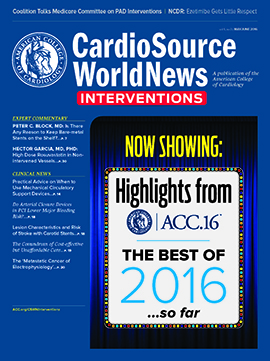Interview: Effects of High Dose Rosuvastatin in Non-intervened Vessels | An interview with Hector Garcia, MD, PhD
CardioSource WorldNews Interventions | High dose rosuvastatin loading before percutaneous coronary intervention (PCI) reduces the myocardial damage and the incidence of adverse cardiac events in patients with stable angina and acute coronary syndrome. However, recently, no studies were present focusing on rosuvastatin loading in patients with ST-segment elevation myocardial infarction (STEMI) in a primary PCI setting until the Integrated Biomarker and Imaging Study (IBIS). CardioSource WorldNews: Interventions spoke with Hector Garcia, MD, PhD, FACC, about the final results of IBIS-3 on the use of rosuvastatin in non-intervened vessel of a real-practice population.
CSWN: Interventions: Tell us about the IBIS-3 trial and what you found.
Hector Garcia, MD, PhD: The IBIS-3 study was a single-center, 300-patient study aiming at imaging the patients at index, and then repeating the imaging at 12 months. We wanted to test the effects of rosuvastatin in the coronary artery of those patients by means of using intravascular ultrasound, mainly, but, also, particularly, with the use of the radiofrequency analysis, which is commercially called virtual histology, and with the TVC NIRS catheter. We imaged one of the non-culprit or non-target vessels in this population, a segment a bit longer than 48 millimeters. We had a study population with a very broad spectrum of coronary aortic disease. We included patients from stable angina, unstable angina, non-STEMI and STEMI populations.
Our primary endpoint was the change in the necrotic core, as evaluated by radiofrequency IBIS analysis. For that particular endpoint, we found no significant change from baseline to follow-up, when considering the necrotic core volume as the primary endpoint. And, similarly, for another key secondary endpoint, which was the change in LCBI, an index measuring the amount of lipid in the coronary arteries, using this TVC catheter, we also did not observe any significant change in the segments with this catheter over the 12-month period.
So we could conclude two things: On one hand, rosuvastatin did not change the signal coming out of these two different imaging modalities, which is very hard to accept, but that could be a real observation. Or, on the other hand, the other endpoint that we have elected for this study was perhaps not the best for evaluating the facts of rosuvastatin. So there are two angles.
But the time of follow-up may be a factor, as we have only a traditional 12-month follow-up. Perhaps we were reimaging those patients too shortly after the intervention, and we could have maybe waited another year to see an effect.
Tell us about IBIS-4, the substudy of the COMFORTABLE AMI trial of individuals who underwent stenting for ST-segment elevation. What did this analysis of the “virtual histology” on the non-target lesion vessels show?
IBIS-4 was another multi-modality imaging study but, in this case, a multi-center study of STEMI patients, treating the culprit artery. We imaged the newly stented vessel, as well as the other two vessels in the same patient. So the full coronary tree was imaged at baseline with two different imaging modalities—virtual histology and optical coherence tomography (OCT).
We gave study patients 40 mg of rosuvastatin for a period of 13 months, and we will repeat that in the three coronary vessel of those patients, using OCT and virtual histology. So the observations from that study—with necrotic core being the primary endpoint—for the radiofrequency analysis, we did not observe any change, similarly to the IBIS-3 findings, in this post-STEMI population; however, our OCT findings were of interest.
For OCT, we wanted to measure the change in the thickness of the fibrous cap. Because the resolution of the imaging modality is about 10-15 microns, we were able to capture the small changes occurring over time in the fibrous cap. We observed a thickening in the fibrous cap, suggesting less-vulnerable spots. We also observed a reduction in the lipid pool as measured by OCT. And maybe a unique finding is the fact that we measured the accumulation of macrophages at index and then repeated that OCT analysis at the follow-up, and we observed a reduction in the accumulation of macrophages in the vessel wall of those patients.
So you could say, so far, considering IBIS-3 and IBIS-4 together, with 1-year treatment with rosuvastatin, we did not change the amount of necrotic core present in those vessels but, when we use the OCT—perhaps because of the resolution of the imaging modality—we observe significant changes in the thickness of the fibrous cap, reduction in the lipid pool, and also a reduction in the macrophage accumulation.
So do you think there is still a benefit to better understanding vulnerable plaque?
When we see these dramatic reductions in cardiovascular events after starting treatment with statins, we need some explanation as to why that is happening. One way to do that is by imaging the actual plaques that are being treated. But that’s not the only way—we have other tools like biomarker and genetic assessments. Assessing changes in all those areas would impact or explain the reductions in cardiovascular outcomes in these statin trials. We are just coming with one piece of the puzzle and trying to contribute to that whole discussion to better understand how we are impacting the cardiovascular outcomes of our patients.
But we aren’t just focusing on the vulnerable plaque, the focal changes in the vessel wall that may not have any clinical impact—we are also focusing on the vulnerable patient.

|
Read the full May/June issue of CardioSource WorldNews Interventions at ACC.org/CSWNI |
Keywords: CardioSource WorldNews Interventions, Acute Coronary Syndrome, Angina, Stable, Biomarkers, Myocardial Infarction, Myocardium, Percutaneous Coronary Intervention
< Back to Listings
